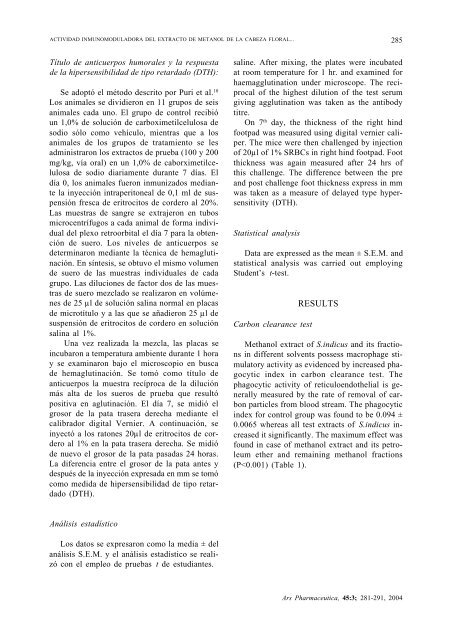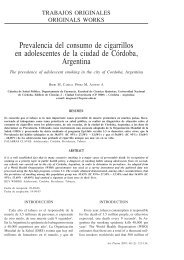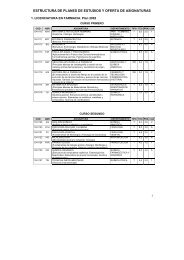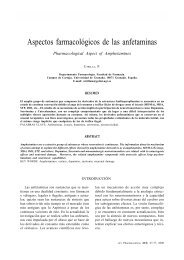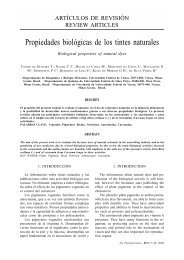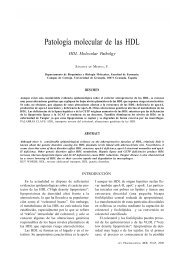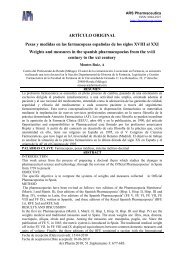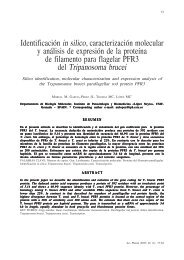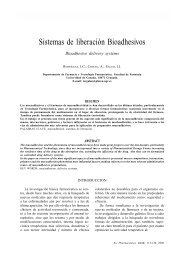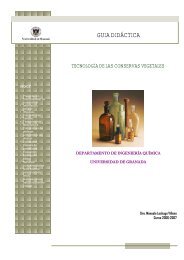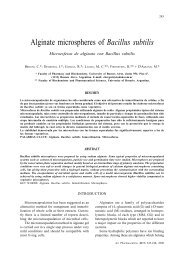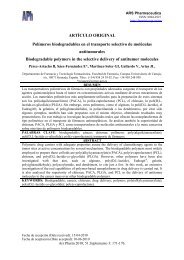Actividad inmunomoduladora del extracto de metanol de la cabeza ...
Actividad inmunomoduladora del extracto de metanol de la cabeza ...
Actividad inmunomoduladora del extracto de metanol de la cabeza ...
You also want an ePaper? Increase the reach of your titles
YUMPU automatically turns print PDFs into web optimized ePapers that Google loves.
ACTIVIDAD INMUNOMODULADORA DEL EXTRACTO DE METANOL DE LA CABEZA FLORAL...<br />
Título <strong>de</strong> anticuerpos humorales y <strong>la</strong> respuesta<br />
<strong>de</strong> <strong>la</strong> hipersensibilidad <strong>de</strong> tipo retardado (DTH):<br />
Se adoptó el método <strong>de</strong>scrito por Puri et al. 10<br />
Los animales se dividieron en 11 grupos <strong>de</strong> seis<br />
animales cada uno. El grupo <strong>de</strong> control recibió<br />
un 1,0% <strong>de</strong> solución <strong>de</strong> carboximetilcelulosa <strong>de</strong><br />
sodio sólo como vehículo, mientras que a los<br />
animales <strong>de</strong> los grupos <strong>de</strong> tratamiento se les<br />
administraron los <strong>extracto</strong>s <strong>de</strong> prueba (100 y 200<br />
mg/kg, vía oral) en un 1,0% <strong>de</strong> caborximetilcelulosa<br />
<strong>de</strong> sodio diariamente durante 7 días. El<br />
día 0, los animales fueron inmunizados mediante<br />
<strong>la</strong> inyección intraperitoneal <strong>de</strong> 0,1 ml <strong>de</strong> suspensión<br />
fresca <strong>de</strong> eritrocitos <strong>de</strong> cor<strong>de</strong>ro al 20%.<br />
Las muestras <strong>de</strong> sangre se extrajeron en tubos<br />
microcentrífugos a cada animal <strong>de</strong> forma individual<br />
<strong><strong>de</strong>l</strong> plexo retroorbital el día 7 para <strong>la</strong> obtención<br />
<strong>de</strong> suero. Los niveles <strong>de</strong> anticuerpos se<br />
<strong>de</strong>terminaron mediante <strong>la</strong> técnica <strong>de</strong> hemaglutinación.<br />
En síntesis, se obtuvo el mismo volumen<br />
<strong>de</strong> suero <strong>de</strong> <strong>la</strong>s muestras individuales <strong>de</strong> cada<br />
grupo. Las diluciones <strong>de</strong> factor dos <strong>de</strong> <strong>la</strong>s muestras<br />
<strong>de</strong> suero mezc<strong>la</strong>do se realizaron en volúmenes<br />
<strong>de</strong> 25 µl <strong>de</strong> solución salina normal en p<strong>la</strong>cas<br />
<strong>de</strong> microtítulo y a <strong>la</strong>s que se añadieron 25 µl <strong>de</strong><br />
suspensión <strong>de</strong> eritrocitos <strong>de</strong> cor<strong>de</strong>ro en solución<br />
salina al 1%.<br />
Una vez realizada <strong>la</strong> mezc<strong>la</strong>, <strong>la</strong>s p<strong>la</strong>cas se<br />
incubaron a temperatura ambiente durante 1 hora<br />
y se examinaron bajo el microscopio en busca<br />
<strong>de</strong> hemaglutinación. Se tomó como título <strong>de</strong><br />
anticuerpos <strong>la</strong> muestra recíproca <strong>de</strong> <strong>la</strong> dilución<br />
más alta <strong>de</strong> los sueros <strong>de</strong> prueba que resultó<br />
positiva en aglutinación. El día 7, se midió el<br />
grosor <strong>de</strong> <strong>la</strong> pata trasera <strong>de</strong>recha mediante el<br />
calibrador digital Vernier. A continuación, se<br />
inyectó a los ratones 20µl <strong>de</strong> eritrocitos <strong>de</strong> cor<strong>de</strong>ro<br />
al 1% en <strong>la</strong> pata trasera <strong>de</strong>recha. Se midió<br />
<strong>de</strong> nuevo el grosor <strong>de</strong> <strong>la</strong> pata pasadas 24 horas.<br />
La diferencia entre el grosor <strong>de</strong> <strong>la</strong> pata antes y<br />
<strong>de</strong>spués <strong>de</strong> <strong>la</strong> inyección expresada en mm se tomó<br />
como medida <strong>de</strong> hipersensibilidad <strong>de</strong> tipo retardado<br />
(DTH).<br />
Análisis estadístico<br />
Los datos se expresaron como <strong>la</strong> media ± <strong><strong>de</strong>l</strong><br />
análisis S.E.M. y el análisis estadístico se realizó<br />
con el empleo <strong>de</strong> pruebas t <strong>de</strong> estudiantes.<br />
285<br />
saline. After mixing, the p<strong>la</strong>tes were incubated<br />
at room temperature for 1 hr. and examined for<br />
haemagglutination un<strong>de</strong>r microscope. The reciprocal<br />
of the highest dilution of the test serum<br />
giving agglutination was taken as the antibody<br />
titre.<br />
On 7 th day, the thickness of the right hind<br />
footpad was measured using digital vernier caliper.<br />
The mice were then challenged by injection<br />
of 20µl of 1% SRBCs in right hind footpad. Foot<br />
thickness was again measured after 24 hrs of<br />
this challenge. The difference between the pre<br />
and post challenge foot thickness express in mm<br />
was taken as a measure of <strong><strong>de</strong>l</strong>ayed type hypersensitivity<br />
(DTH).<br />
Statistical analysis<br />
Data are expressed as the mean ± S.E.M. and<br />
statistical analysis was carried out employing<br />
Stu<strong>de</strong>nt’s t-test.<br />
Carbon clearance test<br />
RESULTS<br />
Methanol extract of S.indicus and its fractions<br />
in different solvents possess macrophage stimu<strong>la</strong>tory<br />
activity as evi<strong>de</strong>nced by increased phagocytic<br />
in<strong>de</strong>x in carbon clearance test. The<br />
phagocytic activity of reticuloendothelial is generally<br />
measured by the rate of removal of carbon<br />
particles from blood stream. The phagocytic<br />
in<strong>de</strong>x for control group was found to be 0.094 ±<br />
0.0065 whereas all test extracts of S.indicus increased<br />
it significantly. The maximum effect was<br />
found in case of methanol extract and its petroleum<br />
ether and remaining methanol fractions<br />
(P


